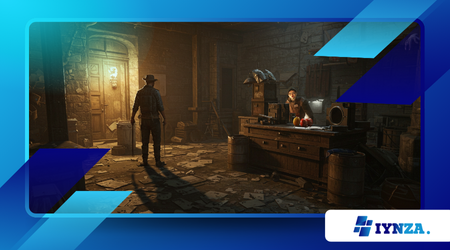Por qué los juegos independientes son el corazón de la industria del juego

¿Por qué los juegos independientes son el corazón de la industria del juego?
Anuncios
En el núcleo de la creatividad, la resiliencia y la innovación de la industria del juego se encuentra una fuerza poderosa: los desarrolladores independientes. En 2025, está más claro que nunca que los juegos independientes son el corazón de la industria del juego.
Estos son los títulos que toman riesgos, desafían las tendencias y priorizan la pasión sobre las ganancias.
Si bien los juegos exitosos dominan los titulares, es la escena independiente la que ofrece constantemente profundidad emocional, mecánicas innovadoras y narrativas audaces.
Los jugadores de todo el mundo recurren a los juegos independientes no sólo para entretenerse, sino para conectarse. Estos proyectos a menudo reflejan historias personales, ideas poco convencionales y voces nuevas de comunidades subrepresentadas.
Sin la presión de las expectativas del mercado masivo, los desarrolladores independientes crean juegos que resuenan a un nivel más profundo: juegos que plantean preguntas, superan los límites y experimentan sin miedo.
Su trabajo nos recuerda que los juegos pueden ser más que un espectáculo; Pueden ser arte, protesta, terapia o las tres cosas a la vez.
La libertad de innovar
Una de las razones principales por las que los juegos independientes se destacan es la libertad creativa. Sin niveles de supervisión corporativa, los estudios independientes pueden correr riesgos que las empresas más grandes evitan.
No están limitados por fórmulas, proyecciones financieras ni objetivos trimestrales. Esa libertad conduce a la innovación: mecánicas de juego que no se han probado antes, narrativas que exploran temas incómodos o no contados y una estética que desafía las convenciones.
Juegos como estos desafían lo que el medio puede ser. Ofrecen nuevas formas de interactuar, sentir y pensar. Algunos utilizan el diseño minimalista para contar historias poderosas.
Otros utilizan controles no convencionales o rompen la cuarta pared para aumentar la inmersión. Estos no son trucos, son expresiones de libertad, e impulsan la industria hacia adelante al mostrar lo que es posible cuando los desarrolladores siguen la visión en lugar de las tendencias del mercado.
Lea también: Juegos en la nube vs. juegos tradicionales: ¿cuál es mejor?
Una plataforma para nuevas voces
Los juegos independientes a menudo sirven como plataforma para voces marginadas en el mundo de los videojuegos. Sin las barreras de la publicación tradicional, desarrolladores de diversos orígenes pueden dar vida a sus historias.
Esto da como resultado experiencias que se sienten frescas, personales y profundamente humanas. El espacio independiente da lugar a perspectivas que a menudo se pasan por alto, ya sea a través de narraciones culturales, personajes no tradicionales o juegos que exploran la salud mental, la identidad y el duelo.
Los jugadores tienen hambre de autenticidad. En una época en la que el contenido convencional inunda las tiendas, la crudeza de los títulos independientes parece honesta y necesaria.
Estos juegos conectan a nivel emocional, no porque sean perfectos, sino porque son sinceros. Las imperfecciones a menudo se convierten en parte de su encanto, reflejando el esfuerzo muy humano que hay detrás de ellas.
Desarrollo centrado en la comunidad
A diferencia de muchos lanzamientos convencionales, los juegos independientes a menudo se desarrollan en estrecha colaboración con sus comunidades.
Los desarrolladores comparten registros de desarrollo, abren pruebas beta y reciben comentarios directos de los jugadores durante el desarrollo. Esta transparencia genera lealtad y conduce a juegos que realmente reflejan las necesidades y los deseos de quienes los juegan.
Los jugadores que apoyan los títulos independientes a menudo se sienten parte del proceso. Son testigos de primera mano del crecimiento, los reveses y los triunfos del desarrollo.
Este sentido de propiedad y propósito compartido crea una conexión más fuerte entre el creador y la audiencia.
A cambio, los desarrolladores se sienten empoderados por una comunidad que cree en su visión, incluso cuando va en contra de las normas de la industria.
Rompiendo los límites del género
Los títulos convencionales tienden a permanecer en su línea: juegos de disparos en primera persona, juegos de rol de mundo abierto y lanzamientos deportivos anuales. Los juegos independientes ignoran esos carriles.
Mezclan géneros, inventan otros nuevos y crean híbridos que desafían una clasificación fácil. Un juego puede mezclar la mecánica del ritmo con el terror, mientras que otro combina la resolución de acertijos con una narrativa meditativa sobre la pérdida.
Estos experimentos a menudo conducen a resultados sorprendentes. Algunos fracasan, otros se convierten en clásicos de culto y unos pocos redefinen su género por completo.
Pero el éxito en el mundo independiente no siempre se mide por las ventas. Se mide por el impacto: cómo un juego resuena, inspira o deja una marca.
Esa voluntad de experimentar evita que el panorama de los videojuegos se estanque y recuerda a los estudios más grandes la importancia del riesgo creativo.
Profundidad emocional sin ruido
Los juegos independientes suelen ser más silenciosos, más lentos y más reflexivos que sus contrapartes convencionales. No dependen de explosiones cinematográficas ni de mundos abiertos extensos para mantener a los jugadores interesados.
En cambio, utilizan el estado de ánimo, el diálogo, el ritmo y la música para crear una conexión. El resultado es una intimidad emocional que se siente rara y valiosa.
No solo estás viendo el viaje de un personaje: lo estás sintiendo. Ya sea un juego de dos horas sobre reconectarse con la familia o una aventura surrealista a través de los recuerdos de alguien, los juegos independientes se destacan en la narración emotiva.
Y como no están rellenos de contenido innecesario ni distracciones, dejan espacio para que surja el significado. Te alejas de ellos no con adrenalina, sino con reflexión.
Las herramientas de desarrollo accesibles impulsan la creatividad
El surgimiento de herramientas de desarrollo potentes y asequibles ha nivelado el campo de juego. Motores de juego como Unity y Unreal, tiendas de activos, tutoriales en línea y plataformas de financiación como Kickstarter o Itch.io han hecho posible que cualquiera con una visión pueda darle vida. Esta accesibilidad ha inundado el espacio independiente con creatividad.
Un equipo pequeño, o incluso un desarrollador individual, ahora puede crear una experiencia que rivaliza con estudios más grandes en diseño y perfeccionamiento.
Esta democratización de la creación significa que se exploran más ideas, más personas se involucran y se superan más límites. No se trata sólo de juegos pequeños. Se trata de oportunidades más amplias y una innovación más profunda.
Resiliencia económica a través de la independencia
La industria del juego es conocida por sus ciclos: auges, caídas, tendencias y disrupciones. Los desarrolladores independientes están en una posición única para capear estos cambios.
Debido a que operan con presupuestos más pequeños y equipos más compactos, pueden adaptarse rápidamente, adaptarse a nuevas plataformas y sobrevivir a cambios del mercado que podrían paralizar a estudios más grandes.
Esta agilidad también permite que los juegos independientes exploren plataformas emergentes antes.
Ya sea que se trate de experimentar con juegos en la nube, VR, AR o dispositivos portátiles, los desarrolladores independientes suelen ser los primeros en crear la próxima gran novedad. Y cuando las empresas tradicionales dudan, los creadores independientes avanzan y dan forma al futuro mientras otros esperan.
Impacto cultural a largo plazo
Muchos de los juegos más comentados en los últimos años no provienen de editoriales AAA, sino de estudios independientes.
Estos títulos han influido en el diseño convencional, han inspirado a nuevos desarrolladores y han provocado conversaciones globales. Han ganado premios, han cambiado las expectativas y han redefinido lo que pueden ser los juegos.
Su huella cultural es significativa no por los presupuestos de marketing, sino por lo que representan. Demuestran que el corazón, la honestidad y la imaginación importan.
Demuestran que los juegos pequeños pueden contar grandes historias. Y recuerdan a la industria que la innovación a menudo comienza lejos de los focos.
Conclusión
Los juegos independientes son el corazón de la industria del juego porque encarnan todo lo que hace que el medio sea poderoso: creatividad, riesgo, honestidad y conexión. No se dejan llevar por las tendencias del mercado sino por la visión personal. Hablan con voces que de otra manera podrían pasar desapercibidas. Y se atreven a probar lo que otros no quieren.
A medida que el mundo de los videojuegos se vuelve más comercial y más competitivo, los desarrolladores independientes siguen siendo una fuente vital de innovación y alma. Mantienen los juegos humanos.
Siguen sorprendiéndolo. Y garantizan que los jugadores siempre tengan acceso a historias que reflejen quiénes somos, qué tememos y qué esperamos llegar a ser.
Preguntas frecuentes
1. ¿Por qué se considera que los juegos independientes son el corazón de la industria?
Porque priorizan la creatividad, la profundidad emocional y la visión personal por encima de las fórmulas lucrativas.
2. ¿Los juegos independientes realmente influyen en el panorama general de los videojuegos?
Sí. Muchas innovaciones en mecánica y narrativa que aparecen en títulos convencionales tienen su origen en proyectos independientes.
3. ¿Pueden los juegos independientes tener éxito financiero?
Absolutamente. Si bien no todos los títulos independientes se convierten en un éxito, muchos alcanzan el éxito comercial y construyen carreras sustentables para sus desarrolladores.
4. ¿Qué hace que la narrativa de los juegos independientes sea diferente?
A menudo es más personal, experimental y emocionalmente resonante. Los juegos independientes conllevan riesgos que los estudios más grandes evitan.
5. ¿Cómo pueden los jugadores apoyar a los desarrolladores independientes?
Comprando sus juegos, dejando reseñas, compartiéndolos en las redes sociales e interactuando directamente con sus comunidades.
